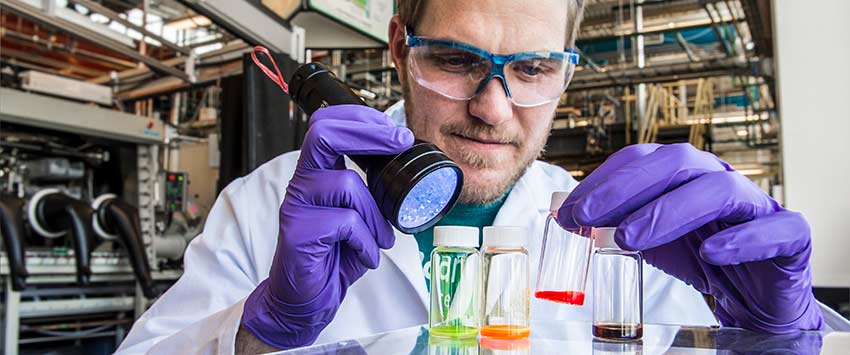NREL Postdoc Awarded for Work on Breakthrough Solar Technology

NREL postdoc researcher Jeffrey Christians has been awarded for his work with a promising solar cell material–perovskites.
Over the past decade, the costs of photovoltaic (PV) systems has consistently declined, their performance has improved, and their share of global electricity generation has grown. For PV systems to become even more widespread, new research must further these trends. One type of materials—halide perovskites—shows promise to continue this trend.
“If we can realize the full potential of these materials, I think we can dramatically transform the energy production landscape of the United States,” said Jeffrey Christians, a postdoctoral researcher at the National Renewable Energy Laboratory (NREL), who recently received a U.S. Department of Energy award to help fund his work.
After studying quantum dots, a different type of semiconductor material, during his undergraduate education, Christian’s interest in nanoscience and energy drew him to study solar cells. “While completing my graduate chemical and biomolecular engineering research at the University of Notre Dame, I became inspired to pursue the challenges of harvesting and harnessing the sun’s energy by my research adviser, Prashant Kamat,” Christians said. “He taught me the vast potential for this technology to transform the way we use and generate energy, and the interesting scientific challenges that stand in the way of fully utilizing solar energy.”
Eventually, the focus of Christians’ solar cell research settled on lead halide perovskites. “Since their discovery in the 19th century, oxide perovskites have found use in fuel cells and as superconductors, as well as in a wide range of other applications. Recently, halide perovskites have emerged onto the scientific scene because of their potential use in photovoltaics and light emitting diodes,” Christians said. After receiving his doctoral degree, Christians joined NREL as a postdoctoral scholar in the group of Joseph M. Luther, working to develop a better understanding of halide perovskite materials.
Much of Christians’ time at NREL is spent making and testing materials and solar cell devices. He performs different analyses to determine materials properties, failure modes, and performance. He collaborates with scientists at NREL and other institutions to ensure his research remains relevant in this quickly advancing field
In 2016, Christians applied to the U.S. Department of Energy’s Energy Efficiency and Renewable Energy (EERE) Postdoctoral Research Awards, a program designed to support researchers as they pursue breakthrough technologies related to renewable energy production.
“Perhaps the biggest benefit I have experienced from working as an EERE postdoctoral fellow is the collaborations that I have fostered,” Christians said. “This fellowship gives me the freedom to interact with a wide group of collaborators and it gives me funds to go to conferences and meet with researchers from around the world. These scientific relationships will definitely help me after my fellowship ends, because I look to start my own research group.” After completing his research program, Christians hopes to become a full-time professor at a college or university to share his love of science with future students.
The EERE Postdoctoral Research Award program is administered by the Oak Ridge Institute for Science and Education (ORISE) for the U.S. Department of Energy. Another version of this article, written by Emily Isaacs, originally appeared on the Oak Ridge Institute for Science and Education (ORISE) website. ORISE is a U.S. Department of Energy asset that is dedicated to enabling critical scientific, research, and health initiatives of the department and its laboratory system by providing world class expertise in STEM workforce development, scientific and technical reviews, and the evaluation of radiation exposure and environmental contamination.
Last Updated May 28, 2025
